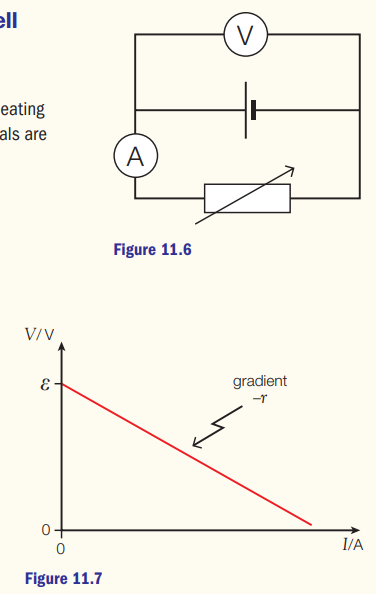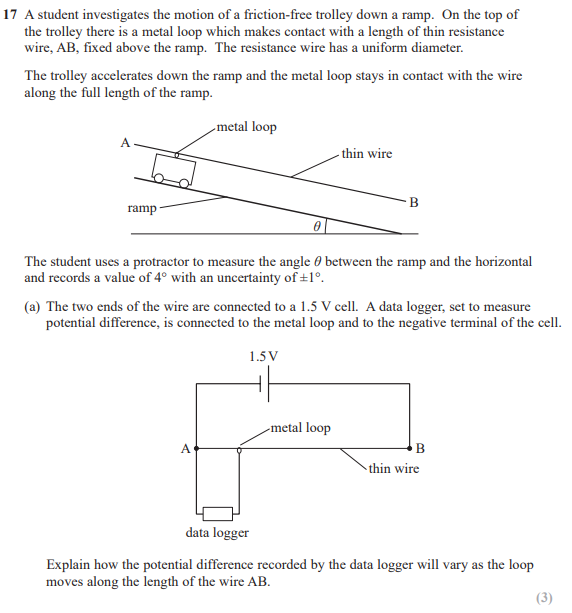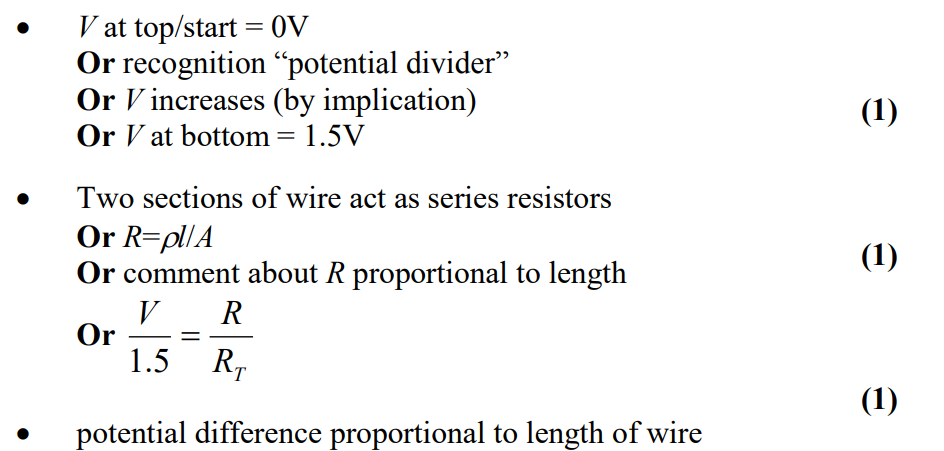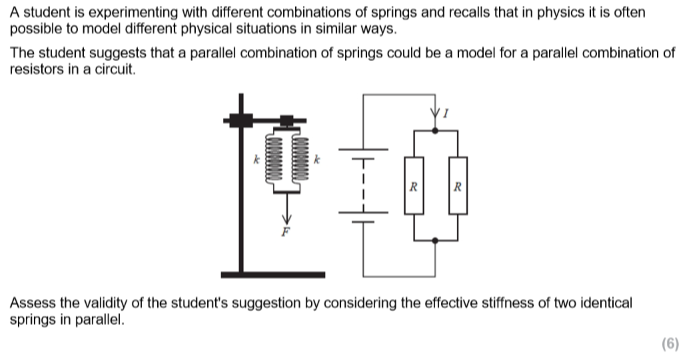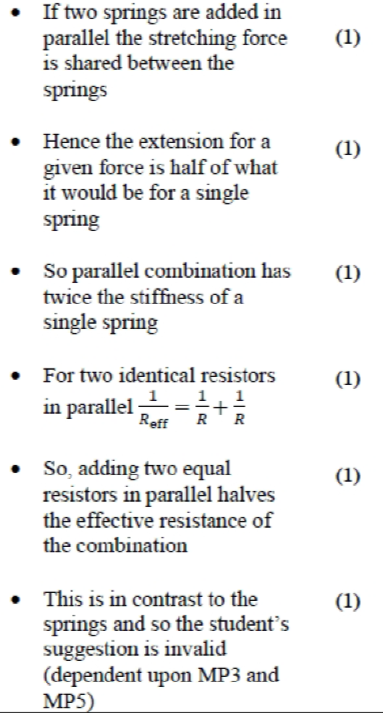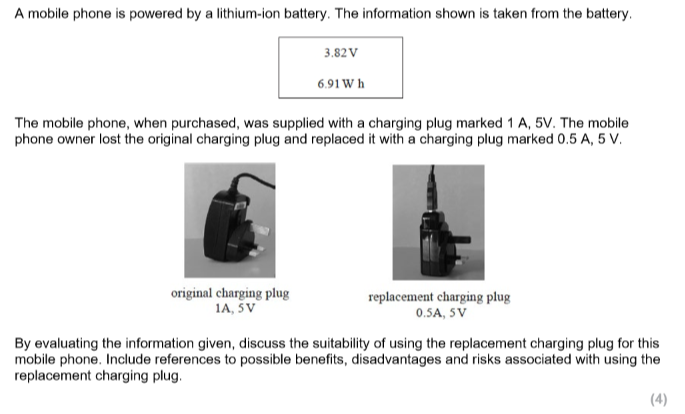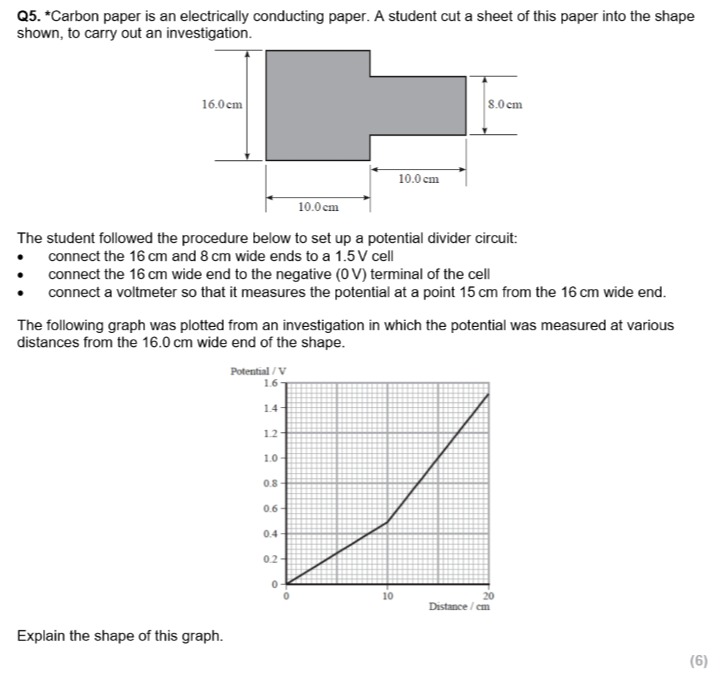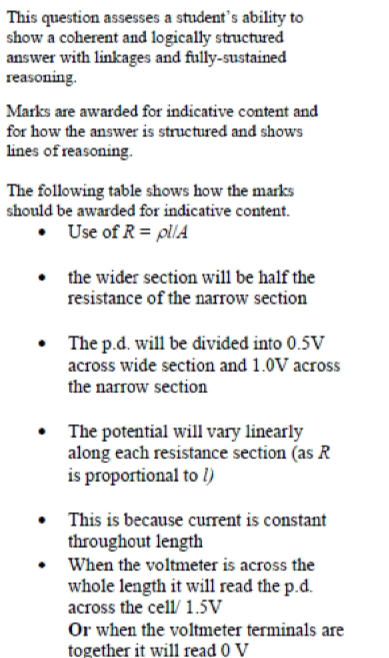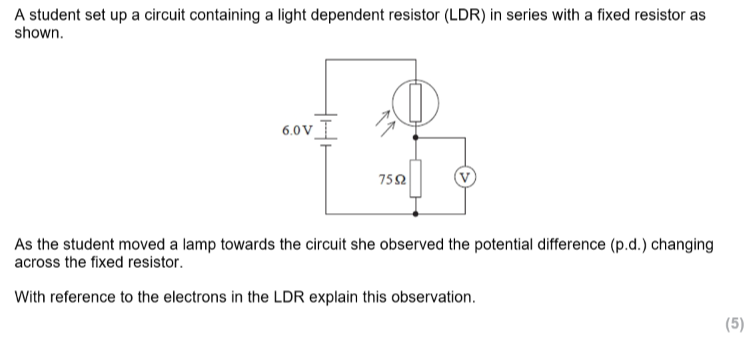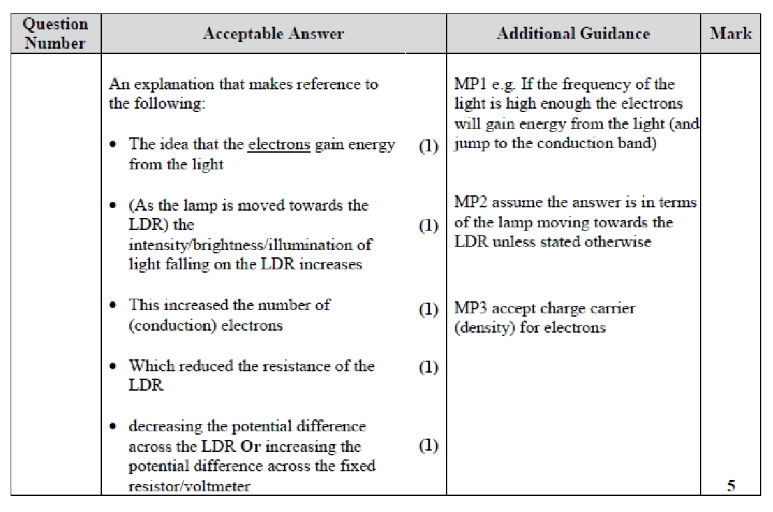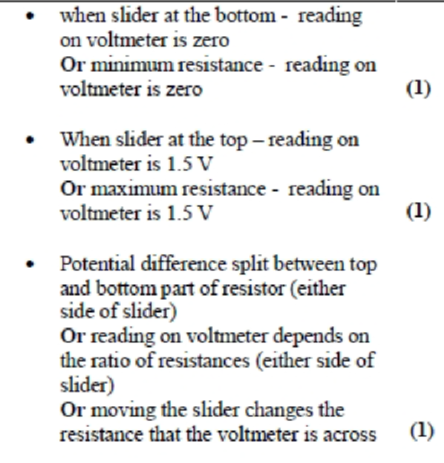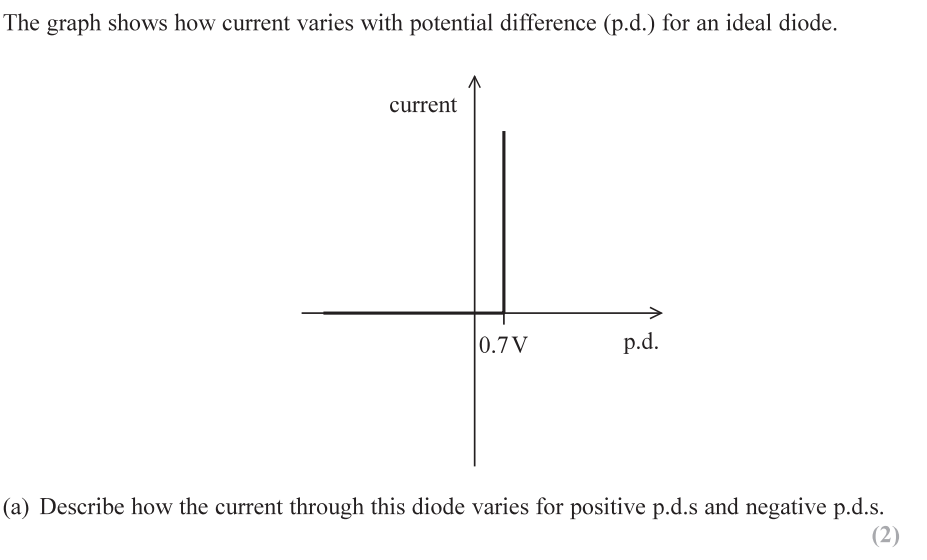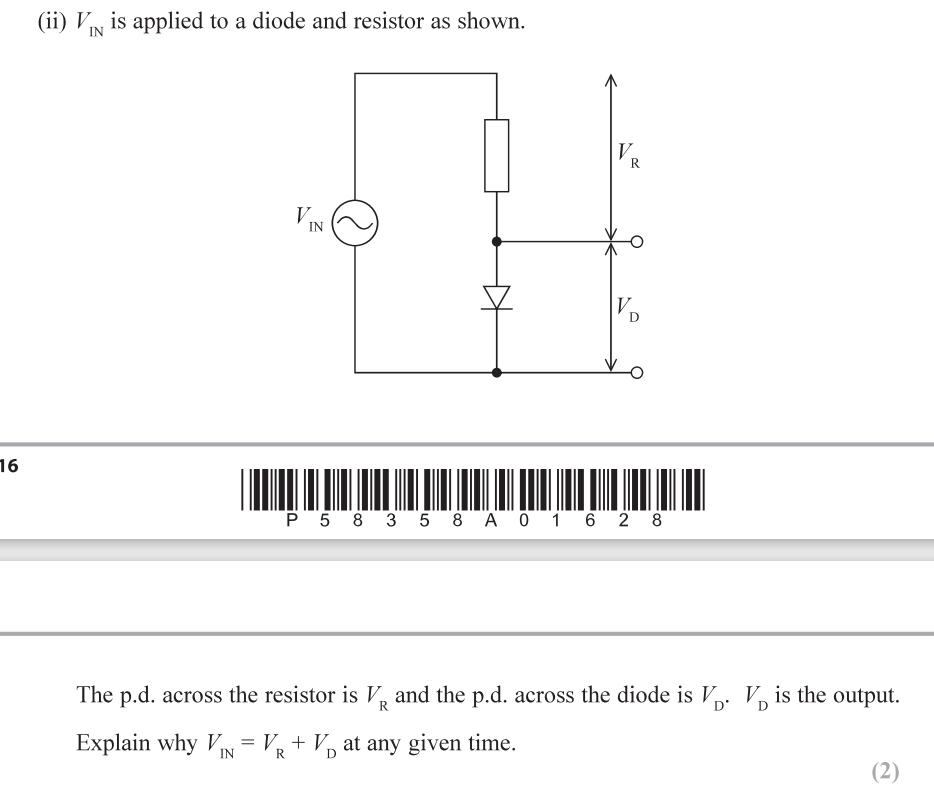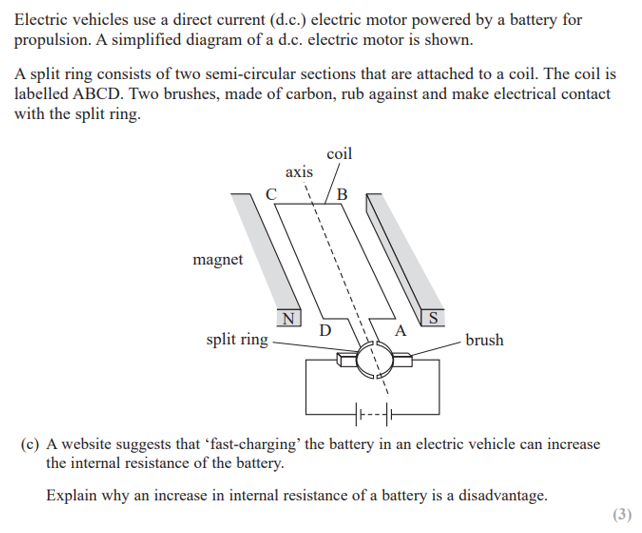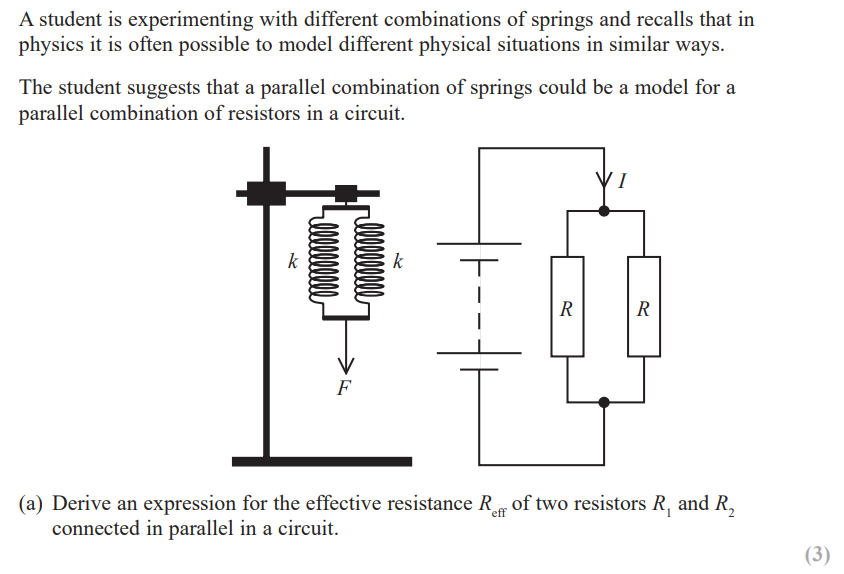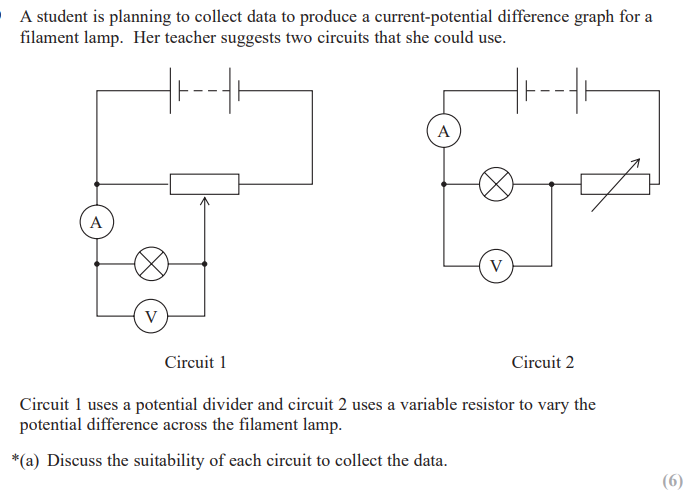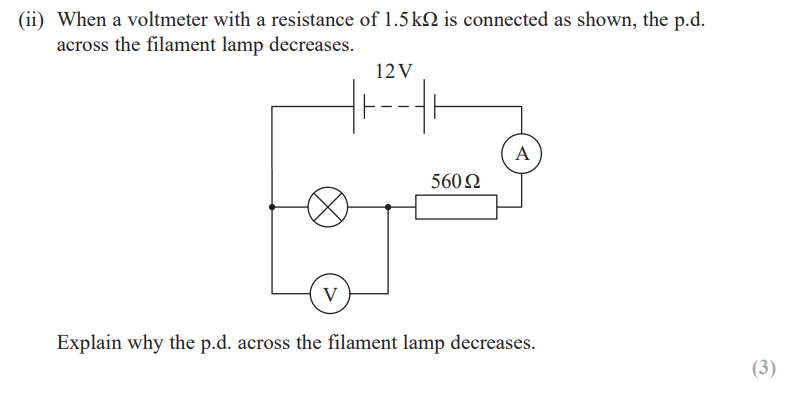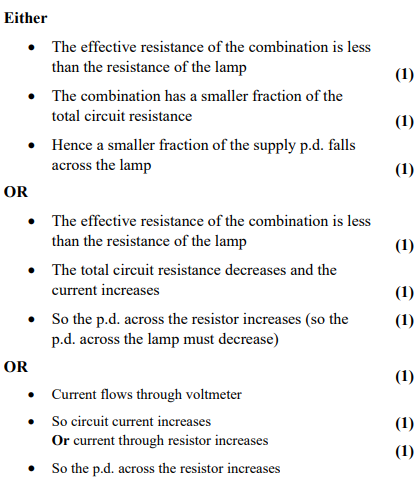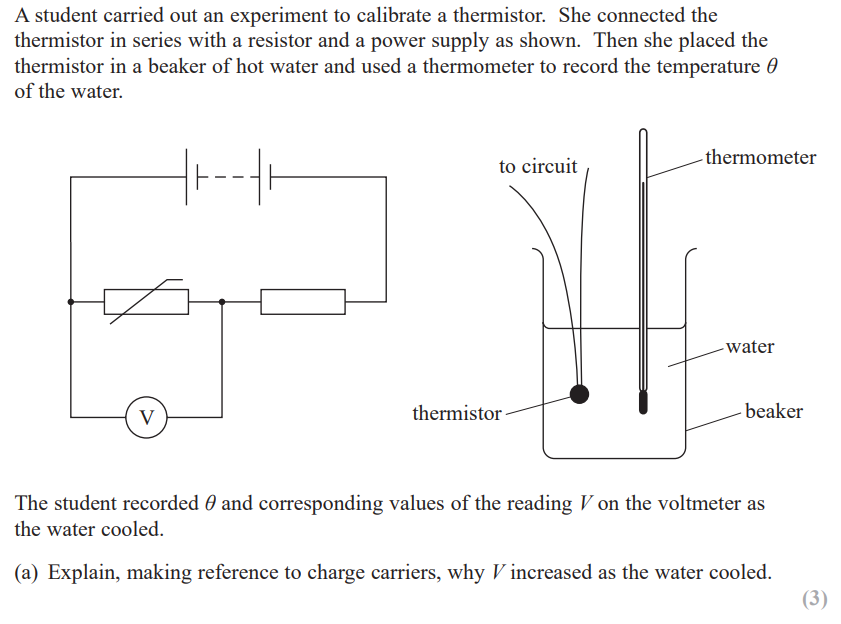Physics - Topic 3 - Electric Circuits
1/89
There's no tags or description
Looks like no tags are added yet.
Name | Mastery | Learn | Test | Matching | Spaced |
|---|
No study sessions yet.
90 Terms
what is electric current?
the rate of flow of charged particles
I=
∆Q/∆t
current is a scalar quantity
V=
W/Q
definition of resistance
R=V/I i.e. the ratio of V:I
the value of potential difference, V, across the component to the current, I, through the component
it is a scalar quantity
what is Ohm’s Law?
a special case of V=IR
a special instance where I ∝ V at a constant temperature
the current flowing through a device is directly proportional to the potential difference applied across the device provided the temperature remains constant
what is the charge on an electron?
1.6×10-19 C
what does Kirchhoff’s 1st law state?
the sum of currents flowing into a junction is equal to the sum of currents flowing out of that same junction
charge is conserved at each junction within a circuit
charges cannot simply disappear or get created, so current can’t disappear or be created either
features of an ideal ammeter
ammeters are connected in series within a circuit
an ideal ammeter has zero resistance - to ensure it does not take a share of the potential difference
in practice ammeters have a small electric resistance
exam question usually assume ideal ammeters
why is the current the same in each component in a series circuit?
this is because the rate at which electrons leave any component must be the same as the rate at which they enter the component. if this were not the case, electrons would be lost from the circuit, which would contravene the principal of conservation of charge.
features of an ideal voltmeter
voltmeters are connected in parallel within a circuit
an ideal voltmeter has infinite resistance - to ensure it does not take a share of the current
has high resistance so negligible current in the voltmeter because that would change/increase current in ammeter
in practice, voltmeters have a very high resistance. typically MΩ and kΩ for digital and analogue meters respectively.
what is 1KWh in Joules?
= IVt = Pt = E = W
= 1000W x 1hour
= 1000W x 3600s
= 3,600,000J
( = 3.6MJ)
definition of power
electric power is defined as the rate at which electric energy is transferred
it is a scalar quantity
how to derive P = I²R
P = IV
as V = IR substitute V for IR
P = I²R
how to derive P = V²/R
P = IV
as I = V/R substitute I for V/R
P = V²/R
what is resistance (joule) heating?
this is the same as the thermal energy transferred to a component
if the component is at a constant temperature, the heat transfer takes place at a constant rate
energy transferred = electrical power x time
energy transferred = I²R x t
W = IVt
cathode ray oscilloscope
a cathode ray oscilloscope has an infintely high resistance. it makes an excellent voltmeter.
the vertical divisions give an indication of the voltage input. the scale can be changed using the volts/div control
an AC input varies with time and the timebase can be varied to calculate the frequency
how many electrons does one Coulomb of charge contain?
6.25 × 1018 electrons
what is voltage?
an indication of how much energy the electrons are given by the cell
it tells you how many joules of electrical energy each coulomb of charge is carrying around a circuit
what does emf stand for and what is it?
electromotive force, ε, is when the charges gain electrical energy from a power supply
it is defined as the energy transferred per unit charge, converted into electrical energy by the source
energy supplied to a circuit
ε = W/Q
referred to when talking about cells
what is potential difference?
when the charges lose electrical energy to a component
the p.d. between two points in a circuit is the electrical energy per unit charge converted to other forms of energy
electrical energy transferred between two points
referred to when talking about components
what is Kirchoff’s Second Law?
for any complete loop of a circuit, the sum of EMF’s round the loop is equal to the sum of potential difference drops around the loop
what is a charge carrier?
an electron detached from its atom or an ion in a conducting material that is free to flow in order to create a current
what happens when a polythene strip is rubbed with a duster?
electrons move from the duster to the strip, making the strip negative (and leaving the duster positive)
what happens when an acetate strip is rubbed with a duster?
electrons move from the strip to the duster, making the strip positive (and leaving the duster negative)
I = (equation including drift velocity)
nAvq
A is the area of the cross-section of the conductor
n is the number of charge carriers per cubic metre i.e. the number density of the material
q is the charge on each charge carrier
v is the drift velocity i.e. mean velocity of the charge carriers
conductors have a much higher…
number density than insulators. this means they are better electrical conductors
as conductors have a higher number density, the drift velocity of conductors must be lower than insulators for the same current to flow
the smaller the cross-sectional area (A) of the wire…
the faster the drift velocity (v) of the electrons in the wire in order to maintain a constant current.
by considering current as the rate of flow of charge, suggest why the current in each resistor in a series circuit such as this must be the same.
by the conservation of charge, the rate of flow of charge (i.e. the current) must be the same throughout the circuit because there is nowhere else for the charge to go. therefore the current must be the same in each resistor.
with reference to the equation, explain why metals, such as copper, are much better conductors of electricity than semiconductors, such as silicon
n for copper is very much greater than n for silicon and so more charge will flow per second in the copper (assuming the same order of magnitude for v) - this means that copper is a better conductor
a car of mass 840 kg is driven up a hill of vertical height 15 m in 3.1 s
suggest why, in practice, the car would have to generate more power than this
in practice, the car would have to generate more power than this in order to do work against air resistance and rolling resistance. the latter is the energy transferred when a tyre is rolling due to the constant deformation of the tyre
explain, with reference to energy, what is meant by an emf of 12V
an emf of 12V means that the battery converts 12J of chemical energy into electrical energy for every 1C of charge that passes through the battery
explain why the filament lamp uses more energy than the LED.
nearly all the LED power is converted to visible light but only about 10% of the filament lamp’s power is converted into energy in the visible spectrum - the rest is mainly in the infra-red region.
state what physical quantity is represented by each term in the equation I = nAvq
I - current
n - number of charge carriers per unit volume
A - area of cross-section normal to current
v - drift velocity of charge carriers
q - charge on each charge carrier
N in SI units
kgm/s²
Pa in SI units
kg/m/s²
J in SI units
kgm²/s²
how do you interpret that two lamps are connected across the same power supply?
they are connected in parallel
derive equation for calculating resistance of resistors in series
using Kirchoff’s 1st Law, the current through both resistors is the same
Kirchoff’s 2nd Law: Vₜ = V₁ + V₂
IRₜ = IR₁ + IR₂
the common factor of I can be cancelled out
Rₜ = R₁ + R₂
derive equation for calculating resistance of resistors in parallel
according to Kirchoff’s 1st Law: Iₜ = I₁ + I₂
according to Kirchoff’s 2nd Law:
Vₜ/Rₜ = V₁/R₁ + V₂/R₂
factor of V can be cancelled out
1/Rₜ = 1/R₁ + 1/R₂
definition and formula for resistivity
an intrinsic property of a material that gives a number to how strongly it resists any current
ρ = RA/l
it is a scalar quantity and presumes constant temperature
what is internal resistance?
when a power source delivers a current, the measured p.d. is lower than it should be
this is because the internal resistance of a source causes a loss of potential difference when current passes through it
the lost p.d. is the energy dissipated/wasted inside the cell due to internal resistance
why will the p.d. across the terminals of the power supply be less than the emf of the supply?
because of the voltage lost to the internal resistance
state the equation for calculating emf
E = I(R+r)
state the equation for calculating the power delivered to the load
I²/R
state the derived equation for power
P = E²R/(R+r)²
what can we observe when we plot a graph of power vs load resistance?
the maximum power is delivered to the load when the load resistance = the internal resistance
when can a temperature controlled circuit be used?
this circuit would be good to automatically switch a heater on or off.
when can a light controled circuit be used?
this circuit would be good to automatically switch on a light when it gets dark
what is a potentiometer?
a three-terminal resistor with a sliding or rotating contact, usually called a Wiper
an advantage of using a potential divider is that the current through the component and the p.d. across it can be reduced to zero - this occurs when using a potentiometer
what is a rheostat?
a resistor used to adjust the magnitude of current in a circuit by changing length
a type of potential divider
uses of potentiometer:
when three terminals are used (three points of contact with potential divider), it forms an adjustable voltage divider
when two terminals are used, it acts as a variable resistor (a rheostat)
explain, with reference to energy, what is meant by a p.d. of 9V
a p.d. of 9V means that the resistor is converting 9J of the electrical energy into thermal energy for every 1C of charge passing through the resistor
the copper wires between the battery and the motor have a diameter of 1cm. explain why such a thick wire is needed. (4)
to prevent large energy dissipation, wire heating up/wire melting
large p.d. across the wires
resistance of cable low
cross-sectional area large
we usually assume ammeters have negligible resistance and voltmeters have infinite resistance. the determination of e.m.f and r is not affected by using an ammeter with non-negligible resistance but is affected by using a voltmeter with a low resistance. explain why.
if ammeter has resistance, current decreased
but doesn’t affect the determination because the voltmeter measures the terminal p.d. for that current
if voltmeter has smaller resistance it would draw current
measured current not current through cell
explain the variation of resistance with potential difference for the filament bulb in terms of particle behaviour. (6)
(As V increases) acceleration/velocity/energy of electrons increases
greater energy transfer in collisions with lattice / ions
increasing the temperature of metal/filament/ions
amplitude of vibrations of lattice/ ions increases
collision (rate) between lattice /ions and electrons increases
due to the increase in resistance, current doesn’t increase in proportion to potential difference
Or due to the increase in resistance the ratio of I/V decreases
describe and explain the change in resistance of the bulb as the potential difference across it is increased (4)
resistance increases
because the temperature increases (accept heats up)
increasing the amplitude of the vibrations of the lattice ions
leading to more frequent collisions of electrons with lattice ions
this resistance combination is used in an electrical circuit. a student measures the potential difference across the combination with a high resistance voltmeter. explain why the resistance of the combination is hardly changed by the addition of the voltmeter.
voltmeter is connected in parallel or voltmeter draws little/no current
resistors in parallel formula with either Rv or large valued used
1/Rv is very small/negligible
explain how the graph could be constructed to obtain better values for e.m.f. and r.
start y-axis at 3.0V
this will allow the plots to be made more accurately/OR this will allow the intercept and change in V to be determined to more s.f./OR this will allow read-offs to be made with more precision
we usually assume that ammeters have negligible resistance and voltmeters have infinite resistance. the determination of e.m.f. and r is not affected by using an ammeter with non-negligible resistance but is affected by using a voltmeter with a low resistance. explain why.
if ammeter has resistance, current decreased
but doesn’t affect the determination because current through cell/r is measured OR doesn’t affect the determination because voltmeter measures terminal p.d. for that current
if voltmeter has smaller resistance it would draw current
measured current not current through cell/r
explain the shape of the graph and why the filament is more likely to fail when being switched on rather than at other times. (5)
intitially the temperature is low so current high
resistance of filament increases as temperature increases
current falls to steady value when temperature is constant
maximum heating is when lamp is switched on/when current is highest
filament breaks due to melting caused by temperature rise

EITHER:
current (from battery) increases
therefore terminal p.d. decreases
so brightness of bulb 1 decreases
OR:
the resistance of the (external) circuit decreases
so there is a smaller proportion of p.d. across the bulbs
so brightness of bulb 1 decreases
a teacher demonstrates the electric field produced between two parallel metal plates. the plates are connected to a variable power supply. the power supply has a very large internal resistance and includes a voltmeter that indicates its output.
explain why the reading on the voltmeter indicates the e.m.f. of the power supply. (2)
as no current drawn from supply
terminal potential difference is equal to e.m.f. OR no potential difference across internal resistance
explain why the voltmeter reading decreases significantly whenever sparks are produced (there is a large internal resistance). (3)
a spark is a current drawn from the supply
a potential difference is produced across the internal resistance of the supply
according to V = E - Ir, V decreases OR the decrease in V is large because the internal resistance is large
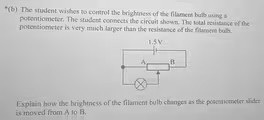
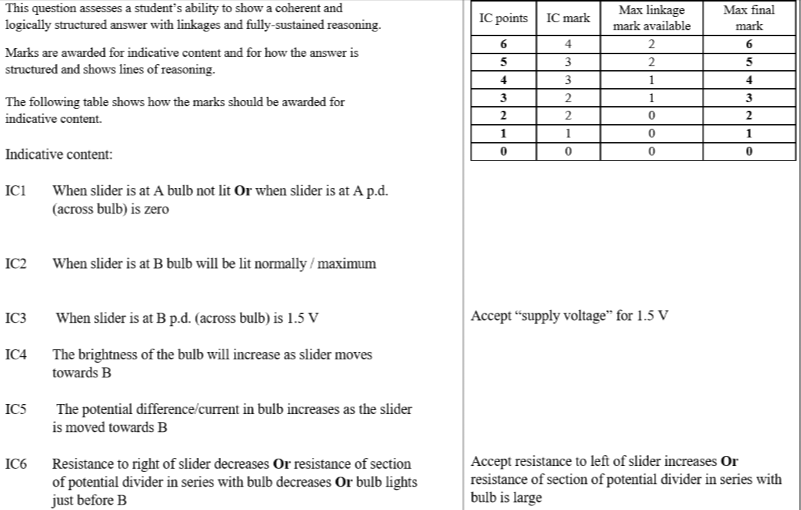
the student connects a filament bulb in a series circuit with a 1.5V cell, a capacitor and a switch. the capacitor is initially uncharged and has a capacitance of 1.2F. the resistance of the filament bulb is 5Ω.
explain how the brightness of the filament bulb will vary as the switch is closed. (4)
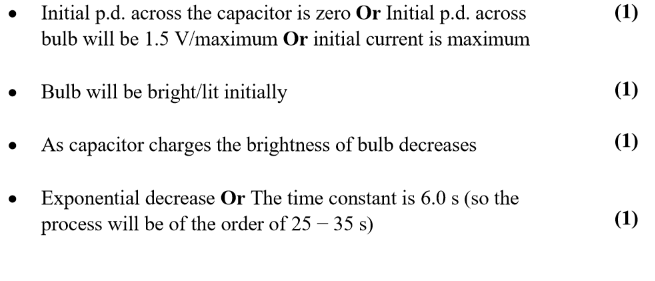
explain why the ammeter reading increases as the LDR was brought closer to the lamp. your answer should include reference to the charge carriers in the LDR. (3)
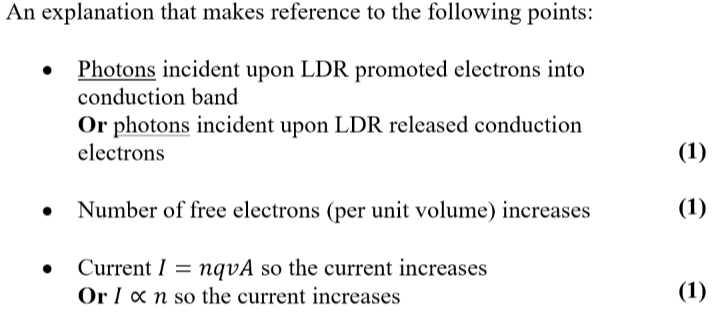
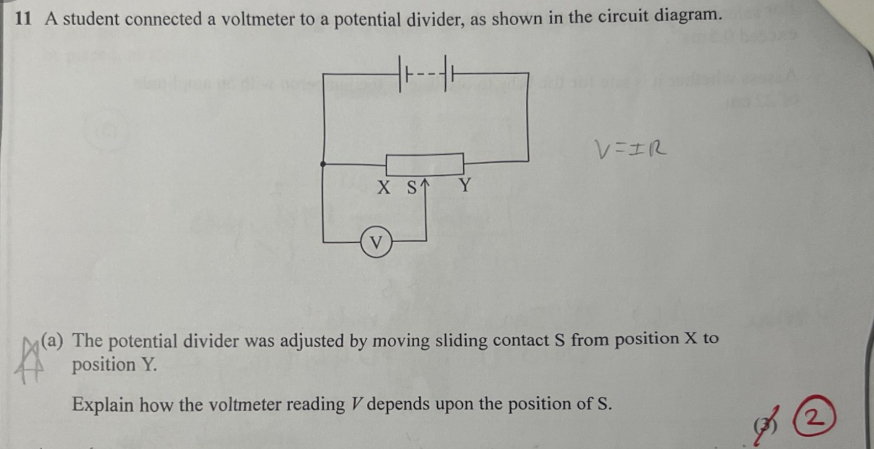
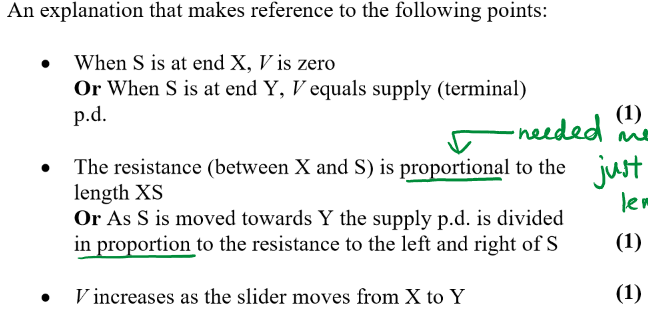
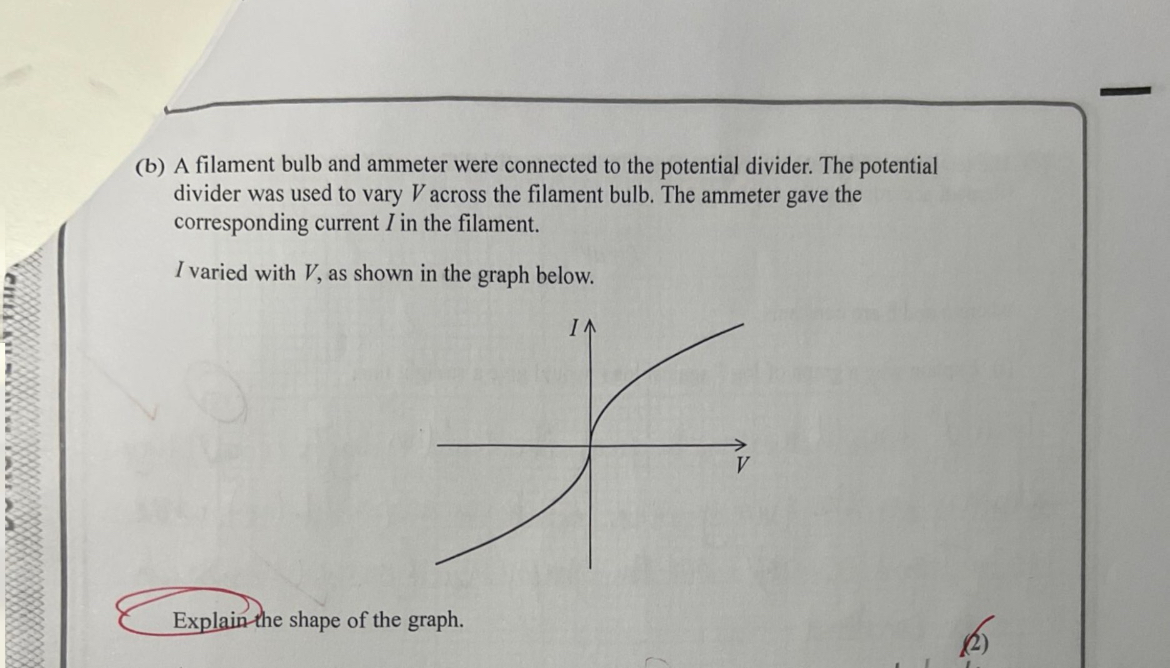

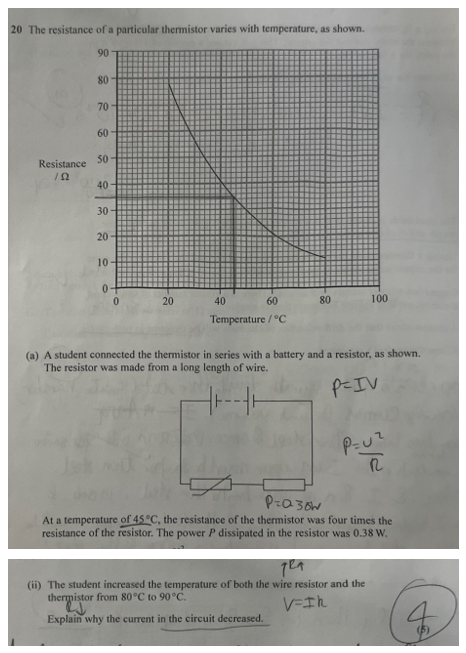
although 5 marks, there are 6 points (could not find mark scheme)
as temperature increased, the amplitude of oscillations of lattice ions in wire increases
therefore electrons collide more frequently with lattice ions
therefore the resistance of the wire increases
the resistance of the thermistor decreases
overall, there is an increase in resistance therefore current in circuit decreases in order to maintain a constant p.d.
so the increase in resistance of the wire resistor must be greater than the decrease in resistance of the thermistor
draw and I-V graph and a V-I graph for an Ohmic conductor (at constant temperature).
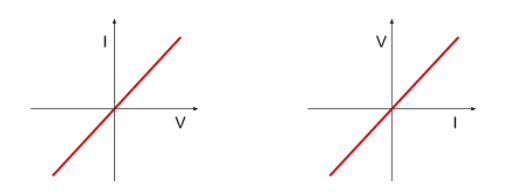
draw and I-V graph and a V-I graph for a filament bulb and explain the shape of the graph.
filament bulbs contain a length of metal wire, which heats up as the current increases, therefore the resistance of this component increases as the current increases
at low currents, the metal wire will not heat up significantly, therefore for low currents Ohm’s law is obeyed
as current increases (in either direction), graph begins to curve due to increasing resistance
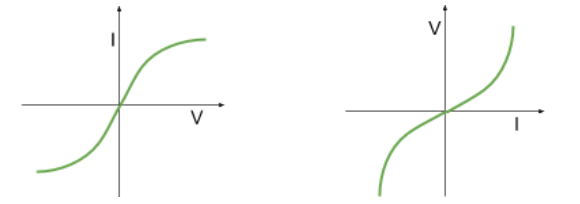
draw and I-V graph and a V-I graph for a (negative temperature coefficient) thermistor and explain the shape of the graph. explain why the resistance of a thermistor decreases as the temperature increases.
as temperature of thermistor increases, resistance of thermistor decreases
this is because increasing the temperature causes electrons to gain kinetic energy and be emitted from the atoms
therefore number of charge carriers and hence number density (number of charge carriers per unit volume) increases
hence current increases and since V = IR, resistance decreases for the same p.d.
at low currents, where temperature is kept constant, Ohm’s law is obeyed
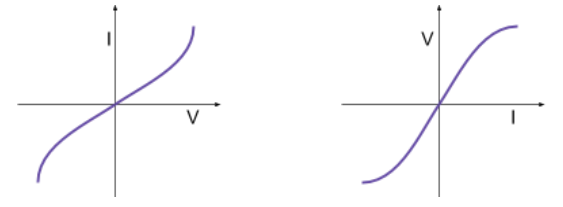
draw and I-V graph and a V-I graph for a (semiconductor) diode and explain the shape of the graph.
must consider forward and reverse bias for a diode
the forward bias of a diode is the direction in which it will allow current to flow easily past the threshold voltage, which is the smallest voltage needed to allow current to flow
in the direction of the reverse bias, the resistance of the diode is extremely high meaning that only a very small current can flow
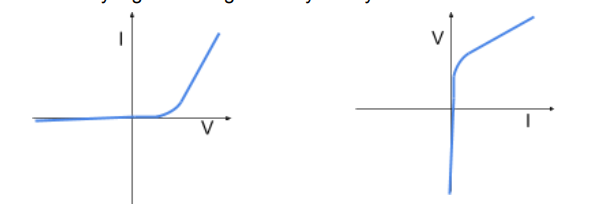
core practical 2: describe an experiment to determine the electrical resistivity of a material. include diagrams in your answer.
measure the diameter of the pencil lead and calculate cross-sectional area of lead
tape the lead to a half-metre rule, with about 1cm protruding beyond the zero end of the rule
set up circuit as shown in Figure 10.7
firm contact is made at different lengths along the lead
the current and potential difference are recorded and the corresponding resistance is calculated for each value of length
a graph of R against l is plotted
R = ρl/A where A = πd2/4 and R/l is the gradient of the graph
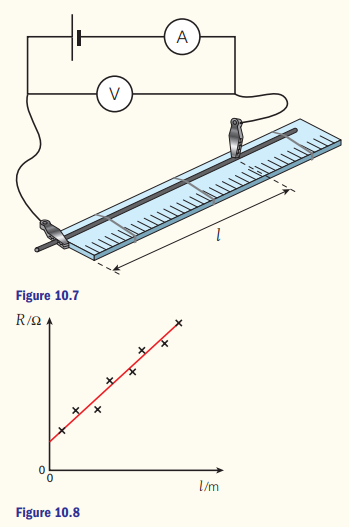
how does potential along a uniform-current carrying wire vary with distance along it?
the resistance of the wire (and therefore potential) increases in proportion (directly proportional) to the length
core practical 3: describe an experiment to investigate the e.m.f. and internal resistance of a cell. a diagram would be useful.
set up circuit as shown in photo
start with variable resistor (rheostat) at its highest resistance value (to minimise any heating effects)
the current in the cell and the potential difference across its terminals are recorded for different setting of the rheostat
rearranging V = ε - Ir:
V = -Ir + ε
plot V against I, gradient of graph = -r which is a constant and y-intercept = ε
(in practice, the line may not be straight because the internal resistance may not be constant - particularly for large currents)
